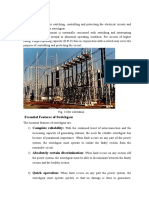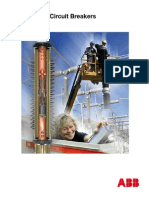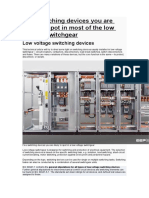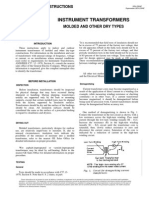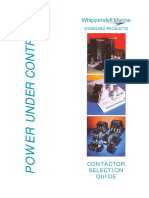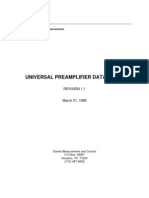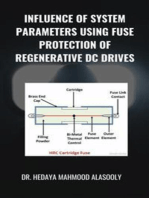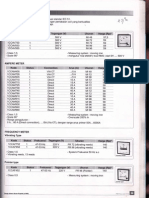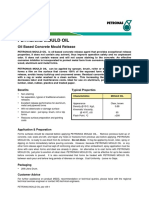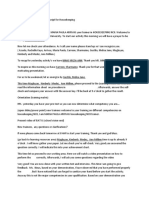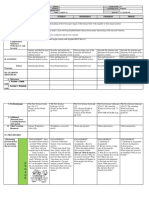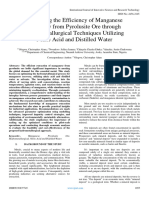Disconnect or Switch
Disconnect or Switch
Uploaded by
qwkerbk090909Copyright:
Available Formats
Disconnect or Switch
Disconnect or Switch
Uploaded by
qwkerbk090909Original Title
Copyright
Available Formats
Share this document
Did you find this document useful?
Is this content inappropriate?
Copyright:
Available Formats
Disconnect or Switch
Disconnect or Switch
Uploaded by
qwkerbk090909Copyright:
Available Formats
Disconnector Switch.
1 - Support insulator 2 - Fixed contact 3 - Moving contact 4 - Coupling contact 5 - Moving earthing contact 6 - Drive insulator 7 - Arcing contact The BS: 3078-1959 on isolators distinguishes between off load and on load isolator as under: 1 - Off Load Isolator is an isolator which is operated in a circuit either when the isolator is already disconnected from all sources of supply or when the isolator is already disconnected from the supply and the current may be due to capacitance currents of bushings, Bus-Bar connections, and very short lengths of cable. 2 - On Load Isolator is an isolator which is operated in a circuit where there is a parallel path of low impedance so that no significant change in the voltage across the terminals of each pole occurs when it is operated.
Disconnector: 12345supporting insulator fixed contact moving contact earthing Switch driving insulator
To ensure that the off load isolators are not operated inadvertently under load it is necessary that the isolators are suitably interlocked with the connected breakers.
Isolating Switches can broadly be divided into the three categories given ahead. a) b) c) Bus isolator. Line isolator. Transformer isolating.
RATINGS AND THEIR SELECTION An isolator may be constructed single pole or three poles and shall be rated in terms of: 1 - Voltage. The rated voltage of an isolator or an earthing Switch shall be one of the highest system voltages, given below: 3, 6, 7.2, 12, 24, 36, 72.5, 123, 145, 245, 300 and 420 kV. 2 - Insulation level. The rated insulation level should be selected from standard Tables according To IS: 9921 3 - Frequency Rated frequency should be 50 Hz in Kuwait. 4 - Normal current (for Disconnector only) The rated normal current of an isolator or an earthing Switch should have one of the following Standard values: 200 A, 400 A, 630 A (alternatively 800 Amps), 1250 A, 1600 A, 2000 A, 2500 A, 3150 A, 5000 A and 4000 A. 5 - Short time withstand current The rated short-time withstands current of a Disconnector or earthing Switch should have one of the following values: 8, 10, 12.5, 16, 20, 25, 31.5, 40, 50, 63, 80 or 100 KA. 6 - Duration of short circuit The short time current rating of an isolator, unless directly associated with and protected by a fuse or by a Circuit Breaker fitted with series releases or current Transformer operated releases
when it need not be assigned a short time rating, should not be less than the short circuit current at the point of installation or the corresponding ratings of the associated Circuit Breaker. The rated maximum duration of short circuit is one second. For short circuit duration greater than one second, the relation between current (I) and time (t), unless otherwise specified, shall be assumed to be in accordance with the formula: t = constant 7 - Peak withstand current The rated peak withstand current of a Disconnector or earthing Switch is that peak current which it shall be able to carry in the closed position without material deterioration. It shall have a value 2.5 times the rated short time withstand current.
8 - Short circuit making current (for earthing Switches only) The earthing Switches to which a rated short circuit making current has been assigned shall be capable of making at any applied voltage, upto and including that corresponding to their rated voltage, any current upto and including their short circuit making current. 9 - Contact zone Divided frame Disconnector and earthing Switches shall be able to operate within the limits of their rated contact zone. For examples of rated contact zones, the reader may refer to IS: 9921 (Part II)-1982. 10 - Mechanical terminal load Disconnector and Earthing Switches should be able to close and open whilst subject to their rated mechanical terminal loads, where assigned, plus wind loads acting on the equipment itself. 11 - Supply voltage closing and opening devices (where these operating devices are supplied separately) of auxiliary circuits, peak power And total duration of operations. The rated supply voltage shall preferably be one of the standard values given below: DC. Volts AC. volts 24 110 Single phase 48 240 Single phase 110 240 /415 three phases 220 The operating device shall be capable of closing and opening the isolator at any value of the supply voltage between 85 percent and 110 percent of the rated voltage.
12 - Supply frequency of closing and opening devices and of auxiliary circuits. The rated supply frequency of an operating device or an auxiliary circuit is the frequency at which the conditions of operation and heating are determined. 13 - Pressure of compressed gas supply for operation. The rated pressure should correspond to the operating pressure of the associated air blast Circuit Breakers, if installed and preferably have one of the following standard values: 500, 1000, 1600, 2000 or 3900 kPa. The pneumatic operating device shall be capable of closing and opening the isolator when the air pressure is between 85 percent and 105 percent of the rated supply pressure.
TESTS 1. Type Tests laid down in IS: 9921(part 4)-1985 A) Normal Type Tests - Dielectric Tests Comprising Of. 1 - Lightning Impulse Voltage Tests 2 - Switching Impulse Voltage Tests for rated 3 - Power Frequency Voltage Tests. 4 - Artificial Pollution Tests. 5 - Partial Discharge Tests. 6- Tests on Auxiliary and Control Circuits. B) Routine Tests The following shall comprise routine tests: 1- Power Frequency Voltage Test, 2-Voltage Test on Auxiliary Equipment. 3- Operation test 4- Measurement of the Resistance of the Main Circuit.
You might also like
- F200Document18 pagesF200Mohammed Madi100% (2)
- Installation And Maintenance Manual JOSLYN P/N 1455-85-M JOSLYN P/N 1455-85-MN Ac Power Arresters 208/120 VAC, 3φ, 4 WIRE, GROUNDED WYEDocument8 pagesInstallation And Maintenance Manual JOSLYN P/N 1455-85-M JOSLYN P/N 1455-85-MN Ac Power Arresters 208/120 VAC, 3φ, 4 WIRE, GROUNDED WYEsrogan2323No ratings yet
- ALSTOM Instntneous Voltage Relay VAGM HighResDocument4 pagesALSTOM Instntneous Voltage Relay VAGM HighResMorgan Brooks0% (1)
- O & M of Sub StationDocument94 pagesO & M of Sub StationAlbert Sekar100% (2)
- Price List SocomecDocument28 pagesPrice List Socomecqwkerbk090909100% (18)
- Peganum Harmala PamphletDocument3 pagesPeganum Harmala PamphletJason SmallNo ratings yet
- Molded Recloser: User'S ManualDocument24 pagesMolded Recloser: User'S Manualjulitssa SarmientoNo ratings yet
- RFL 9550 Line TrapDocument12 pagesRFL 9550 Line TrapSINU0607IITEEENo ratings yet
- Finder General Technical Information enDocument14 pagesFinder General Technical Information enenerconNo ratings yet
- Electrical Safety - Nfpa RequirementsDocument19 pagesElectrical Safety - Nfpa Requirementsapi-249056023No ratings yet
- 01 s0201 RCCB F 360 XDocument16 pages01 s0201 RCCB F 360 XfndprojectNo ratings yet
- SwitchgearDocument23 pagesSwitchgearAnonymous Yq9ibs100% (3)
- Buyers Guide HV Live Tank Circuit Breakers Ed5 en PDFDocument126 pagesBuyers Guide HV Live Tank Circuit Breakers Ed5 en PDFaalisafaNo ratings yet
- Method Statement Capacitance & Dissipation FactorDocument4 pagesMethod Statement Capacitance & Dissipation Factorsite.eng1No ratings yet
- 26MR70Document28 pages26MR70jotas2525No ratings yet
- ABB RCCB F 804Document12 pagesABB RCCB F 804catalinccNo ratings yet
- 07.circuit BreakerDocument14 pages07.circuit BreakerDhivagar NamakkalNo ratings yet
- Introduction of Ring Main UnitDocument8 pagesIntroduction of Ring Main Unitfaradino100% (1)
- 400KV Circuit BreakerDocument128 pages400KV Circuit BreakerRamakrishna67% (3)
- Catalogo. Aparatos de Maniobra y Proteccion - Sirius. Siemens PDFDocument52 pagesCatalogo. Aparatos de Maniobra y Proteccion - Sirius. Siemens PDFPedro MalpicaNo ratings yet
- 33kV Breaker SpecDocument19 pages33kV Breaker SpecBala KumaranNo ratings yet
- 13VTL100Document104 pages13VTL100Pedro GabrielNo ratings yet
- Sharp 21MFG1L Chasis GA6Document60 pagesSharp 21MFG1L Chasis GA6Xavier Lg100% (1)
- Service Manual: Color Television Chassis No. GB-3UDocument40 pagesService Manual: Color Television Chassis No. GB-3UEder Espinoza Bajonero100% (1)
- Five Switching Devices You Are Likely To Spot in Most of The Low Voltage SwitchgearDocument15 pagesFive Switching Devices You Are Likely To Spot in Most of The Low Voltage SwitchgearHaris MakrigiannakisNo ratings yet
- DS 2471 ZX-Family enDocument2 pagesDS 2471 ZX-Family enAndrei HorhoianuNo ratings yet
- GE-Instrument Transformer InstallationDocument5 pagesGE-Instrument Transformer InstallationmiveyNo ratings yet
- A Compilation by Virendra SahdevDocument108 pagesA Compilation by Virendra SahdevVirendra Sahdev100% (1)
- 14T1LDocument53 pages14T1Lsuranovi6858100% (2)
- ABB Low Voltage Surge Arrester PDFDocument8 pagesABB Low Voltage Surge Arrester PDFrajpre1213No ratings yet
- Gek 34124GDocument24 pagesGek 34124GgusgifNo ratings yet
- Chapter 2: Final Circuit & Load Estimation: Hasnizam Hanafi Pusat Pengajian Kejuruteraan Sistem ElektrikDocument54 pagesChapter 2: Final Circuit & Load Estimation: Hasnizam Hanafi Pusat Pengajian Kejuruteraan Sistem ElektrikRaj Kumar GiriNo ratings yet
- STD Data IEC62271Document4 pagesSTD Data IEC62271Theresa WestNo ratings yet
- Surge ArrestorDocument15 pagesSurge Arrestormichyim100% (1)
- Tes P 119 05 R0Document8 pagesTes P 119 05 R0boopelectraNo ratings yet
- PirDocument31 pagesPirdilipelineNo ratings yet
- The Importance of Earth Loop ImpedanceDocument4 pagesThe Importance of Earth Loop ImpedanceKarim Amer100% (2)
- Circuit Breaker: o o o o oDocument11 pagesCircuit Breaker: o o o o oSry Santos100% (1)
- Contactor Selection GuideDocument6 pagesContactor Selection GuideJovimarkEncarnacionManzanoNo ratings yet
- Is 3 eDocument2 pagesIs 3 emohamedwalyNo ratings yet
- Arrester Joslyn 1456 - 85-LDocument8 pagesArrester Joslyn 1456 - 85-LLisandro GonzalezNo ratings yet
- CA Abb V-ContactDocument92 pagesCA Abb V-ContactWiliam Copacati100% (1)
- Siemens VCB DatasheetDocument48 pagesSiemens VCB DatasheetththeeNo ratings yet
- Vacuum CntactorDocument92 pagesVacuum Cntactorabhi_26t100% (2)
- Telemecanique Power Control & Protection Components TechnicalDocument610 pagesTelemecanique Power Control & Protection Components Technicalslipped_discNo ratings yet
- Icc 1740 V 3Document610 pagesIcc 1740 V 3Richard PuttNo ratings yet
- ABL7REDocument16 pagesABL7REeehassaanNo ratings yet
- 3AH3Document44 pages3AH3wwwdotcomatNo ratings yet
- New Medium Voltage Circuit-Breaker Switchgear With Advanced FunctionalityDocument4 pagesNew Medium Voltage Circuit-Breaker Switchgear With Advanced Functionalityemy1188No ratings yet
- 3089-99 RCCB F660Document16 pages3089-99 RCCB F660Nguyen SonNo ratings yet
- Service Manual: ModelDocument60 pagesService Manual: ModeldonobeeNo ratings yet
- Universal Preamplifier Data Sheet: Revision 1.1Document13 pagesUniversal Preamplifier Data Sheet: Revision 1.1Mohd HassanudinNo ratings yet
- 132 KV Substation Traning Report at HaldiaDocument31 pages132 KV Substation Traning Report at Haldiababli91No ratings yet
- Introduction to Power System ProtectionFrom EverandIntroduction to Power System ProtectionRating: 5 out of 5 stars5/5 (1)
- Analog Dialogue Volume 46, Number 1: Analog Dialogue, #5From EverandAnalog Dialogue Volume 46, Number 1: Analog Dialogue, #5Rating: 5 out of 5 stars5/5 (1)
- Reference Guide To Useful Electronic Circuits And Circuit Design Techniques - Part 2From EverandReference Guide To Useful Electronic Circuits And Circuit Design Techniques - Part 2No ratings yet
- Reference Guide To Useful Electronic Circuits And Circuit Design Techniques - Part 1From EverandReference Guide To Useful Electronic Circuits And Circuit Design Techniques - Part 1Rating: 2.5 out of 5 stars2.5/5 (3)
- Influence of System Parameters Using Fuse Protection of Regenerative DC DrivesFrom EverandInfluence of System Parameters Using Fuse Protection of Regenerative DC DrivesNo ratings yet
- Boat Maintenance Companions: Electrics & Diesel Companions at SeaFrom EverandBoat Maintenance Companions: Electrics & Diesel Companions at SeaNo ratings yet
- Vamp 255Document346 pagesVamp 255Mohanraj NidumoluNo ratings yet
- Bab 3 Harmonisa Tegangan Keluaran Inverter Satu Fasa: Gambar 3.1 Fungsi PeriodikDocument28 pagesBab 3 Harmonisa Tegangan Keluaran Inverter Satu Fasa: Gambar 3.1 Fungsi Periodikqwkerbk090909No ratings yet
- Man Bo-01ka enDocument12 pagesMan Bo-01ka enqwkerbk090909No ratings yet
- Spaj160c Tob 750420encDocument12 pagesSpaj160c Tob 750420encqwkerbk090909No ratings yet
- iCP-440 Capacitor Bank Protection RelayDocument12 pagesiCP-440 Capacitor Bank Protection Relayqwkerbk090909No ratings yet
- Price ListDocument1 pagePrice Listqwkerbk090909No ratings yet
- TRRTR: Ffiffiffiffi Ffiffii#Ffiffiip $FRDocument1 pageTRRTR: Ffiffiffiffi Ffiffii#Ffiffiip $FRqwkerbk090909No ratings yet
- Analisa Harga SatuanDocument4 pagesAnalisa Harga Satuanqwkerbk090909No ratings yet
- Price ListDocument1 pagePrice Listqwkerbk090909No ratings yet
- 3D Disconnectors and Earthing Switches: Answers For EnergyDocument44 pages3D Disconnectors and Earthing Switches: Answers For EnergyMian Qadeer100% (1)
- 3D Catalog HG11 31 enDocument47 pages3D Catalog HG11 31 enqwkerbk090909No ratings yet
- Lampiran: Power of Gensets 20 - 60 kVA 100 - 200 kVA 250 - 550 kVA 650 - 1500 kVADocument1 pageLampiran: Power of Gensets 20 - 60 kVA 100 - 200 kVA 250 - 550 kVA 650 - 1500 kVAqwkerbk090909No ratings yet
- PEUGEOTDocument55 pagesPEUGEOTChristian Loib100% (1)
- Dark Green and Gold Professional Lawyer PresentationDocument15 pagesDark Green and Gold Professional Lawyer PresentationJennilyn SolimanNo ratings yet
- 04 Student Activity 1 - ARGDocument2 pages04 Student Activity 1 - ARGBiancaNo ratings yet
- G. Tyler Miller's Living in The Environment 13th EditionDocument34 pagesG. Tyler Miller's Living in The Environment 13th EditionVona Riski RamadaniNo ratings yet
- Career Avenues Physical MetallurgyDocument27 pagesCareer Avenues Physical MetallurgyAmit Saboo0% (1)
- Dipole Antenna Polarization: Hot-Dip Galvanized Steel. For Side-Mounting To MastsDocument2 pagesDipole Antenna Polarization: Hot-Dip Galvanized Steel. For Side-Mounting To MastsFABIANINo ratings yet
- Corian Material: Corian Is A Brand of Solid, Non-Porous Surface Material Created by DupontDocument9 pagesCorian Material: Corian Is A Brand of Solid, Non-Porous Surface Material Created by Dupontmanoj h sNo ratings yet
- MOULD OIL Pds v09-4Document1 pageMOULD OIL Pds v09-4Axel Mahya AvichenaNo ratings yet
- Lembar Jawaban Skill Lab Evidence Based Medicine Nama: Imanuel Soni NIM: 0401281621123Document23 pagesLembar Jawaban Skill Lab Evidence Based Medicine Nama: Imanuel Soni NIM: 0401281621123SoniNo ratings yet
- D2896 - Standard Test Method For Base Number of Petroleum Products by Potentiometric Perchloric Acid TitrationDocument10 pagesD2896 - Standard Test Method For Base Number of Petroleum Products by Potentiometric Perchloric Acid TitrationEhsan ZiaeiNo ratings yet
- Haematological Parameters and Factors Affecting TH PDFDocument12 pagesHaematological Parameters and Factors Affecting TH PDFZainab HasanNo ratings yet
- Sánchez Berriel, S., Favier, A., Rosa Domínguez, E., Sánchez Machado, I. R., Heierli, U., Scrivener, K., - . - Habert, G. (15 de Junio de 2016)Document3 pagesSánchez Berriel, S., Favier, A., Rosa Domínguez, E., Sánchez Machado, I. R., Heierli, U., Scrivener, K., - . - Habert, G. (15 de Junio de 2016)Jorge GonzalezNo ratings yet
- UDocument1 pageUSemmalarNo ratings yet
- I. Identification Profile: Community Service Action PlanDocument2 pagesI. Identification Profile: Community Service Action PlanNoemi NadadoNo ratings yet
- Mikronik SX Opman V2.00 EngDocument69 pagesMikronik SX Opman V2.00 EngKhaled ZakariaNo ratings yet
- Toaru Majutsu No Index Genesis Testament - Volume 2Document296 pagesToaru Majutsu No Index Genesis Testament - Volume 2Stephen Paul CabalteraNo ratings yet
- Star River Resort Employee Policy ManualDocument14 pagesStar River Resort Employee Policy Manualapi-27015047No ratings yet
- Lps Construction Manual - Part 2Document630 pagesLps Construction Manual - Part 2Carl Williams100% (1)
- Occult Herbmaster - WemutDocument1 pageOccult Herbmaster - WemutRed MartianNo ratings yet
- Fls ScriptDocument2 pagesFls ScriptPau SavirraNo ratings yet
- Who Good Faith-Good Faith Good Faith-Bad Faith Bad Faith-Good FaithDocument1 pageWho Good Faith-Good Faith Good Faith-Bad Faith Bad Faith-Good FaithJohn Marti MaghopoyNo ratings yet
- CH 2 Activity-Based CostingDocument45 pagesCH 2 Activity-Based Costingrusfazairaaf100% (1)
- Are There Many Types of Safety Audit?Document6 pagesAre There Many Types of Safety Audit?Khatri NasrullahNo ratings yet
- A Review On The Effects of Neem (Azadirachta: Indica) As Feed Additive in Poultry ProductionDocument3 pagesA Review On The Effects of Neem (Azadirachta: Indica) As Feed Additive in Poultry Productionjunaida syafNo ratings yet
- Medical Aesthetic Courses: Find A Training Course Near YouDocument8 pagesMedical Aesthetic Courses: Find A Training Course Near YouJanette De los SantosNo ratings yet
- Career Opportunities in Medical TechnologyDocument10 pagesCareer Opportunities in Medical TechnologyMariah Kristine AprodaNo ratings yet
- School: Grade Level: VI Teacher: Learning Area: SCIENCE Teaching Dates and Time: (WEEK 1) Quarter: 2 QuarterDocument8 pagesSchool: Grade Level: VI Teacher: Learning Area: SCIENCE Teaching Dates and Time: (WEEK 1) Quarter: 2 QuarterAlisa Mae SandotNo ratings yet
- Enhancing The Efficiency of Manganese Recovery From Pyrolusite Ore Through Hydrometallurgical Techniques Utilizing Nitric Acid and Distilled WaterDocument13 pagesEnhancing The Efficiency of Manganese Recovery From Pyrolusite Ore Through Hydrometallurgical Techniques Utilizing Nitric Acid and Distilled WaterInternational Journal of Innovative Science and Research TechnologyNo ratings yet











